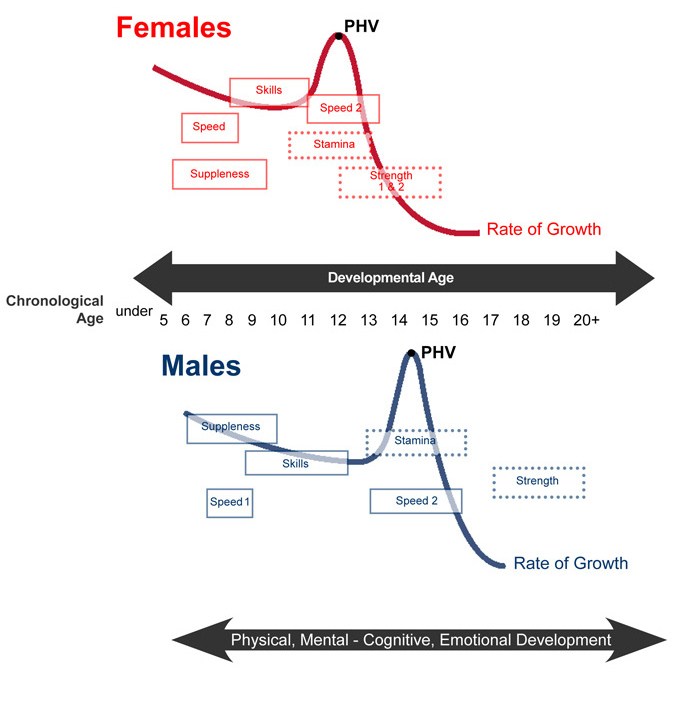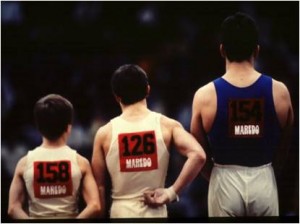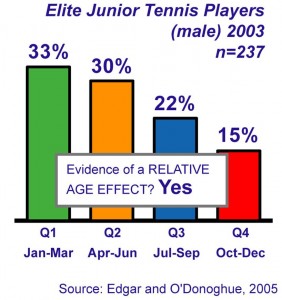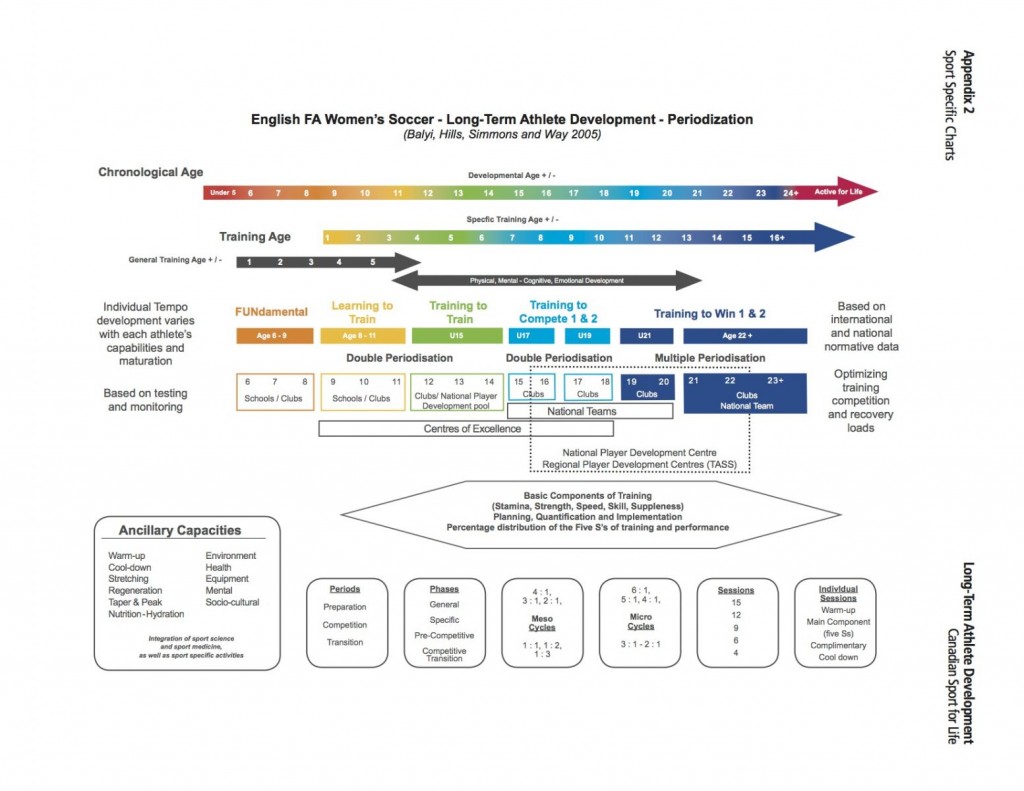1. FUNdamentals
Learning basic movement and sports skills should be made FUN.
All sports begin with basic fundamental movement and core sports skills. The ABC’s of athleticism include agility, balance, coordination and speed, while fundamental movement skills include running, jumping, skating and throwing. Children must have a solid foundation in these fundamental movement skills before they will have success in acquiring sports skills. It has been shown that children who have a strong, broad-based foundation in the fundamental movements and sports skills from a variety of sports, increase their potential for future success in sports. Whether this is confidence to lead a healthy, and active life in sport, or to become an elite athlete, this strong foundation in the FUNdamentals will help children reach their full potential.
2. Specialization
Well-rounded, multisport athletes have the highest potential to achieve.
Sports are classified as either early or late specialization sports. An example of an early specialization sport is women’s gymnastics, where due to growth, girls are potentially retiring from their sport at 14, 15 or 16 years of age. Contact/collision sports, are classified as a late specialization sport. Hockey, Soccer, Football, Tennis, Track & Field are just a few sports where players don’t reach their full potential until after full growth maturity. Specialization at an early age limits children from acquiring a broad spectrum of athletic movements and skills that may limit or put a cap on their overall athletic potential. When players specialize too early they can create imbalances in musculature, increase the potential for burnout and limit their athletic potential by not developing a broad base of athleticism.
AAP Guidelines:
- Encourage athletes to strive to have at least 1-2 days off per week from competitive athletics, sports specific training, and competitive practice to allow them to recover both physically and psychologically.
- Encourage the athlete to take at least two to three months away from a specific sport during the year.
3. Trainability
Missing optimum opportunities significantly affects a child’s ability to reach his or her full potential.
There are identifiable stages during a child’s physical and psychological development that offer optimum opportunities to develop particular attributes such as basic movement skills (agility, balance, coordination and speed), basic sports skills (running, jumping, throwing, skating, and striking), and physical capacities (flexibility, endurance, and strength). Missing these optimum opportunities has been shown to significantly affect a child’s ability to reach his or her full potential.
In our current system, training in early years focuses on outcomes (winning) rather than the developmental process (optimal training).
Elite player development and a sound structure at the 12 & Under level for broad-based skill development are not mutually exclusive. What do we currently produce in Australia? We have an over abundance of average players … very few truly elite players at the very highest levels, especially when our numbers are taken into consideration. This is due to a lack of the proper focus on training through the appropriate trainability.
This diagram (from PacificSport, Balyi et Way, 2005) illustrates windows of optimal trainability for male and female athletes. These critical windows provide accelerated adaptation to training and, if skipped or missed, decrease a child’s chance to reach his or her full potential. It must be kept in mind that all systems are always trainable, yet with smaller degrees of adaptation to training over time. In our current systems, the window of opportunity on skills development (9-12) is missed through over-competition and under-training. We play too many games and do not practice enough when kids are most receptive to acquiring sports skills.
These periods vary between individuals, as each child is unique in his or her genetic makeup. While these periods follow general stages of human growth and maturation, scientific evidence shows that humans vary considerably in the magnitude and rate of response to different training stimuli at all stages. Some players may show potential for excellence at age 11, while others may not indicate their promise until age 15 or 16. Consequently, a long-term approach to player development is needed to ensure that players who respond slowly to training stimuli are not ‘shortchanged’ in their development. (Wellness to World Cup, 2008)
The five trainable physical capacities and windows of optimal trainability are:
Stamina (Endurance):
Optimal trainability occurs at the onset of peak height velocity (PHV). This is more commonly known as the adolescent growth spurt. Aerobic capacity training is recommended before athletes reach PHV. Aerobic power should be introduced progressively after growth rate decelerates.
Strength:
Optimal trainability for girls is immediately after PHV or at the onset of the menarche, while for boys it is 12-18 months after PHV.
Speed:
For boys, the first speed-training window occurs between the ages of 7 and 9 years and the second window occurs between the ages of 13 and 16. For girls, the first speed training window occurs between the ages of 6 and 8 years and the second window occurs between the ages of 11 and 13 years.
Skill:
The window for optimal skill training for boys takes place between the ages of 9 and 12 and between the ages of 8 and 11 for girls.
Suppleness (Flexibility):
Optimal trainability for suppleness for both genders occurs between the ages of 6 and 10. Special attention should be paid to flexibility during PHV.
Additional capacities have been identified that must also be considered throughout an athlete’s development, and in addition to the five physical capacities make up a holistic approach to training.
Structure/Stature:
The height of a person before, during and after maturation can be utilized by a coach or parent. Tracking growth as a guideline for developmental age can allow for planning to take advantage of optimal trainability.
Sustenance:
This category refers to all aspects of replenishing the body for sports and general health. It covers a wide range of topics from nutrition and hydration to rest and recovery. Fatigue, whether it comes from a single practice/competition or builds up over time through a lengthy schedule, can be combated through a proper lifestyle. Whether our children become elite athletes, or we look for better performance in school or just to lead a healthier life, we will all thrive with better education and following a plan that replenishes our physical and mental needs.
School:
Sports schedules must consider the demands placed upon children from an academic perspective. Education must be emphasized, and the demands of sport should complement the academic schedule, not conflict with it. The stress of class work, examinations, boyfriend/girlfriend issues, and school peer groups play a role in the fatigue and stress levels of our athletes. Coaches and parents must monitor these factors to balance the sports schedule to allow for maximum development both on the field and in the classroom.
Psychological:
Sport is a physical and mental challenge. The ability to maintain high levels of concentration, yet remain relaxed with the confidence to succeed, is a skill essential to long-term performance in sport. This skill also has the potential to transcend sport and affect our everyday lives. To develop the mental toughness for success at highest levels, training programs are required that address the specific gender and LTAD stage of players.
4. Ten Year Rule
Refers to the “10 year – 10,000 hour rule” relating to the need of practice for three hours a day for 10 years to become proficient.
It takes years of organized practice to become an expert performer. Research shows this is true of developing any skill, such as learning to play an instrument or playing sport. This is sometimes referred to as the “10 year – 10,000-hour rule” relating to the need to practice for three hours a day for 10 years. This doesn’t mean 10,000 hours of one specific sport. What it does mean is 10,000 hours of athletic development – playing tag, youth soccer, tennis, cricket, AFL, climbing trees or any other activities children engage in.
Many researchers believe this is just a minimum. The bottom line is that it takes an enormous amount of work to become an elite athlete. This is done through a diverse sports movement and sports skills background. Once this foundation is laid, it takes years of deliberate practice to develop an elite performer at the highest level.
And it doesn’t always happen right away. This holds true even for many players that play at the highest levels. A significant percent of these guys were never drafted. This means that at 18 or 19 years of age nobody was even willing to take a late-round chance on their potential to make it. Many sports are not an early specialization sport and our research reflects that. Programs must include a long-term developmental pathway that provides opportunities for our elite players into their early 20s. This is why Advanced Athletes Performance encourages various pathways as it provides the widest range of developmental opportunity over time.
5. Physical/Mental/Cognitive/Emotional Development
Focusing while remaining calm and confident is an essential skill to long-term performance.
The training programs should include key mental components identified by sport psychologists: concentration, confidence, motivation, and handling pressure. As a player progresses through LTAD stages, the mental training aspect will evolve from having fun and respecting opponents, to visualization and self awareness, to goal setting, relaxation, and positive self-talk. To master the mental challenge of sport, these basic skills are then tested in increasingly difficult competitive environments. Ultimately, the planning, implementation, and refining of mental strategies for high-level competition will have a large impact on podium performances. Consequently, the mental training program is critical at all stages of LTAD, as dealing with success and failure will determine continuation in the game and physical activity in general, dramatically affecting both active lifestyle and podium performance. (Wellness to World Cup, 2008)
Essentially, we need to understand that if we are going to teach a child something, as much as we must know the subject matter, we really must have an understanding of where the child is at. We need to be able to relate to them at the level they are most receptive.
6. Biological Age vs. Chronological Age
Chronological age is a poor guide to segregate adolescents for competitions.
Biological age should be considered through our development and identification process. As an example, one only need look at the number of early-month birth dates that make up our Under-17 and Under-18 National Teams. Our current system forces players into a compete-to-win, “peak by the weekend” system that rewards early-maturing players who may not have the ability to be elite performers. Late-developing players are excluded and cut, consequently leaving the sport or being segregated to a recreation program that limits their training opportunities. These late developers may have huge long-term potential but are eliminated from our system.
Currently most athletic training and competition programs are based on chronological age. However, athletes of the same age between ages 10 and 16 can be 4-5 years apart developmentally. Thus, chronological age is a poor guide to segregate adolescents for competitions. In many of our sports especially contact sports, early-maturing players are favored within our youth structure. The late developer is eliminated when, in fact, he or she may possess better long-term athletic ability.
From the above charts it is clear that potential late-month birth date players have been excluded from the high-performance track. It is highly unlikely that there are fewer players with long-term athletic potential born in the last quarter of the year than in the first quarter.
TRAINING AGE
This refers to the age where athletes begin planned, regular, serious involvement in training. The tempo of a child’s growth has significant implications for athletic training because children who mature at an early age have a major advantage during the Train to Train stage compared to average or late maturers. However, after all athletes have gone through their growth spurt, it is often later maturers who have greater potential to become top athletes provided they experience quality coaching throughout that period (England Field Hockey, 2005).
Not all children have the potential to become elite players. The American Development Model recognizes this by offering two levels of content from the Train to Train stage forward. The high-performance content is aimed at those players who have been identified as potential elite performers, while the standard content offers a reduced level of commitment more appropriate to the majority of players who will form the basis of club teams of the future. The split between the levels of content at the early part of the Train to Train stage are relatively small as it is deemed to be such an important stage in developing a broader base of potential elite players.It is important to note that research suggests that there can be numerous players that follow the standard track through the Train to Train and into the Train to Compete stages that will have the potential to become elite performers. This is especially true if they have a diverse sports movement background through playing multiple sports during the FUNdamemtal and Learn to Train stages.
7. Periodization & Training Principles
Segmenting the calendar year into appropriate time intervals for preparation, competition, rest and recovery.
Periodization is the practice of segmenting the calendar year into appropriate time intervals for preparation, competition and rest and recovery. Athletes at different stages of their development require different training plans to optimize their development through their growth and maturation. The science behind periodization has been used on the international stage with great success in many, many sports. Unfortunately, sometimes a sport’s traditions are placed in front of the athlete’s needs when planning a periodization schedule. This has an impact on maximizing the player’s development.
The Great One’s message to parents: Let your kids have fun.
“In youth hockey, in most cases, it’s really important for kids to play other sports – whether it’s indoor lacrosse or soccer or baseball. I think what that does is two things. One, each sport helps the other sport. And then I think taking time off in the off-season – that three or four month window – really rejuvenates kids so when they come back at the end of August, they’re more excited. They think, ‘All right, hockey’s back, I’m ready to go.’”
– Wayne Gretzky
Excerpt from Globe and Mail, September 26, 2008, Erick Duhatschek. Gretzky was a multisport athlete himself growing up – he also excelled in baseball and lacrosse.
TRAINING TO COMPETITION RATIOS
Through a child’s growth and maturation, the athletic development model needs change through different stages. The appropriate training-to-competition ratios need to be adhered to in order to maximize a player’s time and potential. When a heavy emphasis is placed on competition at an early age, two situations occur. One, ice time is directed toward games, which reduces the amount of quality-deliberate practice time. And two, the focus becomes more outcome-based (winning) and less process-driven (learning the game). There are all kinds of arguments put forth as to why we must allow the imbalance in our training-to-competition ratios to continue.
8. System Alignment & Integration
We need a structure that is athlete-centered and looks at the individual player’s development.
The framework for long-term athlete development is influenced by many factors. We have clubs, schools, academies and facilities all with varying interests. To maximize a player’s development needs, it’s important those entities work together and become mutually supportive as each has its part to play. Players will best develop in a system that is clearly defined, logically structured, and based upon consistent principles. We need a structure that is athlete-centered and looks at the individual player’s development. (Wellness to World Cup, 2008)
In a team sport, it is appropriate to look at the collective whole and to provide the direction and lessons that only a team sport can provide. However, we must always consider that each individual is at a different point through the stages of his or her development (early maturer or late maturer for example). The goal is to define our sports system with a pathway that addresses the needs of each individual and maximizes their development as they progress through our system. The LTAD principles shows us that at the earlier ages, both the participants that prefer playing a sport for Life and the ones that end up as high-performance players, should initially be held to the same pathway.
Our current sport system mistakenly allows for the separation of the perceived participants for Life group and the perceived high-performance group before any reliable determination can possibly be made. To maximize each player’s potential, we need the major parties to re-evaluate current practices and base new practices on current legitimate research, instead of commonly held beliefs in sports myths and the old “that’s the way it has always been done” attitude.
We also don’t have the resources to be the sole investor in our children’s future athletic development. We need our kids to take part in other sports, community recreation and school physical education programs. In order to build a sound base in physical literacy we need to encourage our parent to involve their kids with these other entities.
9. Calendar Planning for Competition
There needs to be a better system for how to best use our kids’ time on and off the court or field.
We need to be better about how we’re allocating our kids’ time on the court/field. It’s tough to develop talent when all you’re doing is competing, so we need to be open to a more training-based schedule. One that favors athlete development over competition and one that improves performance capacities.
It’s just as important in planning your calendar to include how the off season will be spent. Make sure there is ample time for kids to not only rest and recover from the season, but pencil in time for playing other sports. Doing this will give kids a chance to recharge their battery in time for the beginning of the new season.
10. Continuous Improvement
The LTAD principles on which AAP strategy is built address core needs for all players.
Continuous improvement is a key underlying principle of long-term athlete development. This ensures that we are always evaluating athletes and are readily able to respond and implement new sports science innovations and observations. LTAD provides a continuously evolving vehicle for change for all emerging facets of physical education and sport and recreation to ensure systematic and logical delivery of programs to all ages.
Advanced Athletes Performance (AAP) along with Parents and Athletes has the mutual goal of seeing more Aussie kids play their chosen sport and compete at the highest levels of the game.






